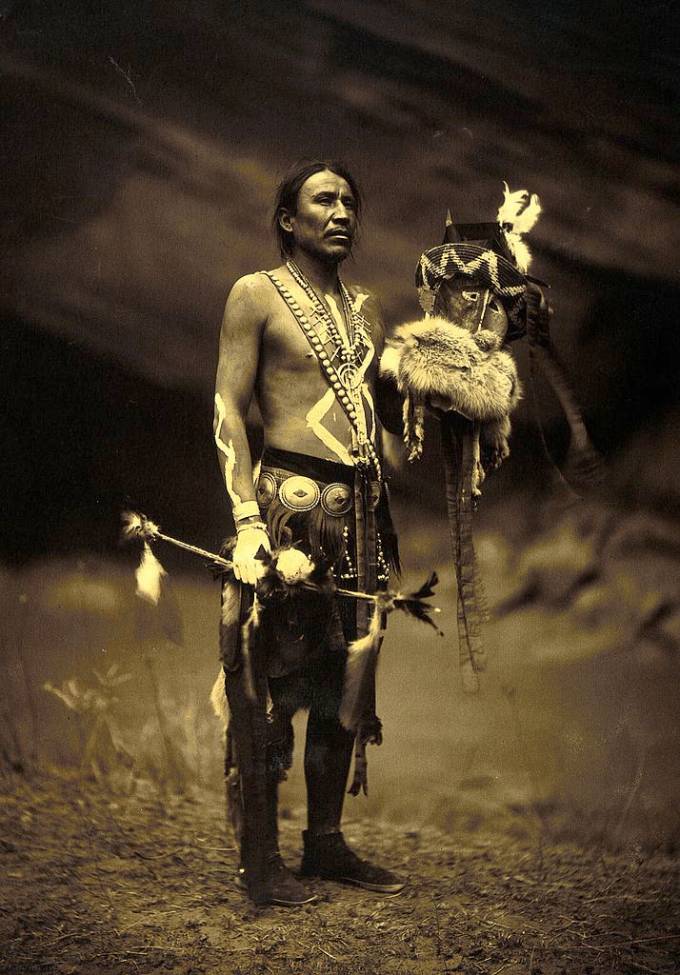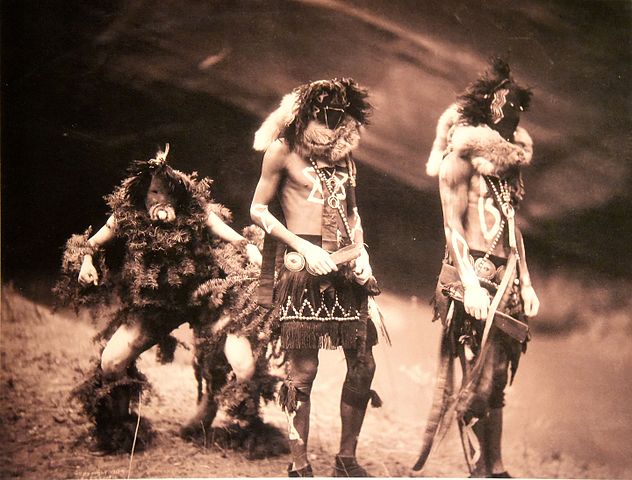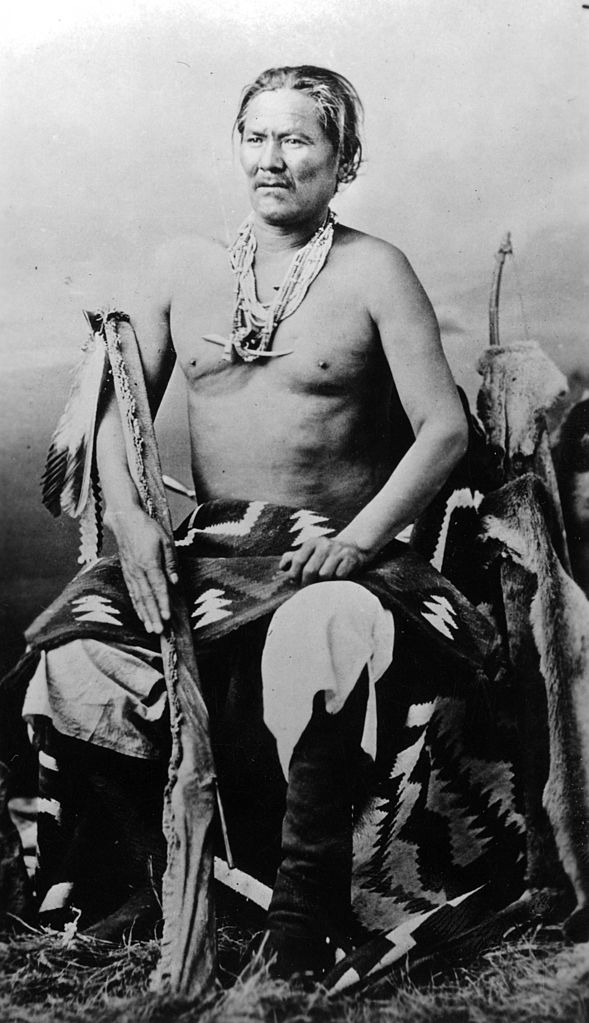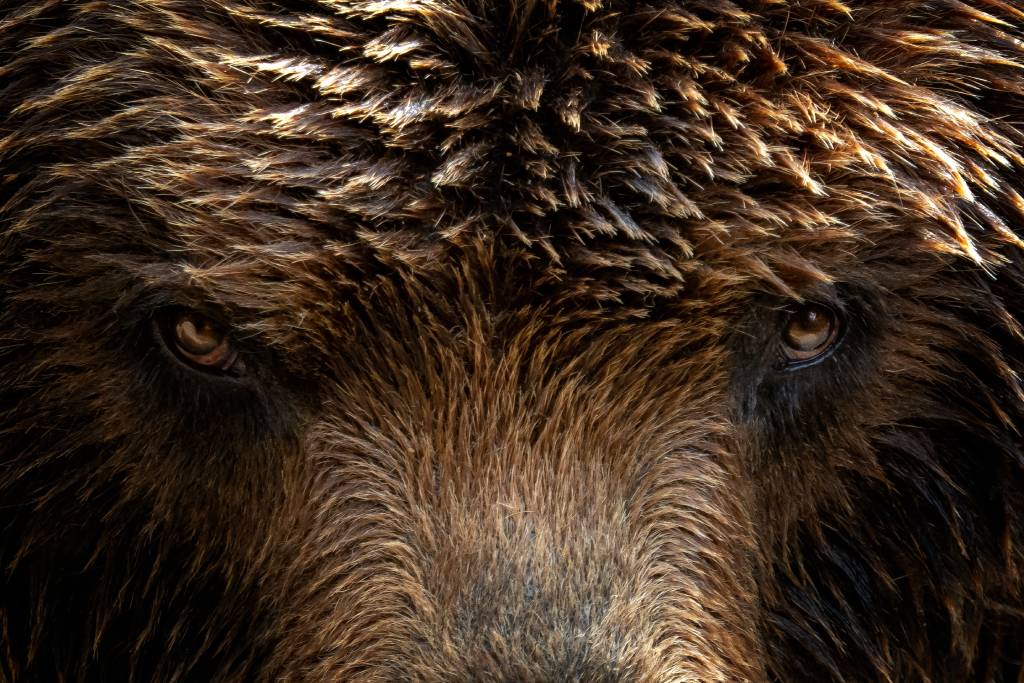Deep in the American Southwest, the indigenous peoples of the Navajo describe their encounters with nefarious shapeshifters known as Skinwalkers.
The exact origin of the Navajo Skinwalker legend is unknown; tales of Skinwalkers are common across Native American reservations. The Navajo, Apache, Hopi, and Pueblo people have their stories of shapeshifting beasts who roam the wild countryside devouring livestock and terrorizing villagers.

The origins of the Navajo Skinwalker
The Navajo explain Skinwalkers as an evil witch or a wicked sorcerer who has mastered the art of black magic and the ability to shape shift.
This Navajo legend has deep roots. Navajo witchcraft culture refers to this creature as ‘yee naaldlooshii,’ which translates as ”by means of it, it goes on all fours”.
Indigenous people describe the Skinwalker as a colossal beast, either a bear or a dire wolf, with glowing red eyes that are almost impossible to kill and impervious to bullets.
However, knives or other weaponry covered in white ash may be enough to finish them off in many stories.
According to Navajo cultural values, there is a deep-seated taboo about discussing the skinwalkers. Native people, including the Navajo, are reluctant to share stories of Skinwalkers with the outside world or within their communities. Saying their name or referring to their activities brings bad luck to the speaker.
There are many varieties of Skinwalkers in other traditions collectively called the ‘ánti’jnii.’
The Nahual
The indigenous tribes of Mexico have the ‘Nahual”.
The result of an evil sorcerer who made a pact with the devil, the Nahual is a shapeshifting magical practitioner who can turn into a large bird, jaguar, or even a donkey. However, some Nahual are believed to be benevolent, and regarded as someone firmly in touch with their animal side.
The Wendigo
According to the native Algonquian Ojibwe, Saulteaux, Naskapi, and Innu tribes of Canada, the Wendigo stalks the forests.
The Wendigo roughly translates as ”the evil spirit that devours mankind” and is a shapeshifting cannibal believed to be a feral monster with human characteristics.
The Wendigo is a giant with a marred face, frightening claws, yellow or grey skin, and an overly long tongue. It is associated with cold weather, starvation, famine, and death. A Wendigo is born whenever a human resorts to cannibalism for survival.
Stories of disturbingly human, shape shifting creatures run up and down the Americas and across Canada. However, it is the Navajo stories that have garnered international attention.
Nowhere more so than at the famously named ‘Skinwalker Ranch.’ On this 500-acre plot in Northern Utah, the Skinwalker Ranch is connected with rumors of Skinwalker appearances, bizarre cattle mutilations, UFO sightings, and even psychic occurrences.
Tales from the Skinwalker Ranch
The Skinwalker Ranch is known for many things. One of the most surprising is that it was previously owned by multi-millionaire and businessman Robert Bigelow.
Bigelow made his millions in the hotel business. Still, his true passion is Aerospace and UFO investigations, even leading a crack team of paranormal investigators—but more on that later.
Bigelow did not buy Skinwalker Ranch as a relaxing retreat. He purchased the Ranch because of his interest in UFOs and the supernatural, and Skinwalker Ranch has a long history of unexplainable occurrences.

The previous occupants of the Ranch reported encounters with monstrous wild beasts, strange lights in the sky, mutilated cattle, and mysteriously damaged recording equipment. Others have experienced apparitions and even sasquatch sightings.
Overall the Skinwalker Ranch contends with Area 51 and the Bermuda triangle regarding allegations of the supernatural and unexplained.
Although not all Native Americans associate the Ranch with Skinwalker legends, the Curse of the Skinwalker Ranch is alive in the Utahn homeland of the Navajo people.
A strange and unexplainable history
The Skinwalker Ranch, previously known as the Sherman Ranch, lies in the heart of the Uintah Basin (also known as the Uinta Basin) in Utah, USA.
Since the time of the Spanish missionaries, the Uintah basin has had an infamous reputation for being a site of significant mystical, paranormal, and sometimes terrifying events.
Haunted gold mines, cursed outlaws, unexplainable deaths, these myths were well known to the early Spanish and Navajo but entirely unknown to the Sherman family who purchased the Ranch in 1994.
After 18 months of living the dream in the American Southwest, Gwen and Terry Sherman encountered a terrifying and unforgettable sight.
A ferocious creature was outside stalking the pens of their livestock. Allegedly it scooped a calf in its jaws and wandered away into the bushes, unharmed and unfazed by the incoming bullets from Terry Sherman’s handgun.
The Shermans describe the creature as a giant wolf or a coyote with a foul stench. As the weeks passed, other people who visited the Ranch reported hearing strange roars and growls and seeing massive beasts moving about the woods.
Unfortunately, the strange happenings didn’t end there for the Sherman family.
Disturbing occurrences
After the wild unidentified animal incident, the Shermans reported seeing strange lights in the sky, and their animals began dying in horrifying ways.
They found the charred remains of their working dogs and livestock that had had their organs bored out of them as though by a surgical knife rather than a wild animal attack. One cow had had a perfectly round hole cut out of its left eyeball.
While living on the Ranch, the Shermans frequently experienced poltergeist activity and heard strange voices in a language they didn’t understand.
And then, one night, several cows disappeared altogether. What baffled Terry Sherman at this point was that whatever had managed to take a 1,400-pound animal without attracting any attention had done so without leaving tracks. On top of this, it had taken more than one animal in a single night.
It is understandable that the Sherman family decided to get as far away from the Ranch as possible and posted it up for sale in 1996, only two years after moving in. The unlikely buyer was Robert Bigelow, who over the past 30 years has spent tens of millions of dollars investigating UFOs and strange phenomena, some at the Skinwalker Ranch, where he experienced eerily similar encounters.
Bigelow bought the Ranch upon hearing about the strange occurrences experienced by the Shermans and set up the National Institute for Discovery Science (NIDS), to set up surveillance and monitor the site.
When he and his team arrived to set up cameras to capture the beasts and strange lights, they would mysteriously wake up to damaged camera equipment as though a large animal had torn it to pieces.
Later, Bigelow sold the Ranch to Adamantium, an ambiguous holding firm owned by TV personality Brandon Fugal who continues to investigate the site.
Criticism of Skinwalker Ranch revelations
Writer and UFO skeptic Robert Sheaffer has dismissed the paranormal shenanigans at the Skinwalker Ranch as likely to be untrue. Despite monitoring, the NIDS team established by Bigelow failed to gather proof of unusual activity. Sheaffer also reveals that the ranch owners before the Shermans lived there for 60 years with no supernatural occurrences.
Sheaffer asserts, “the parsimonious explanation is that the supernatural claims about the ranch were made up by the Sherman family prior to selling it to the gullible Bigelow.” The writer also reveals that the more fantastical claims can be traced to Terry Sherman.
Sheaffer has not been alone in his skepticism. Colm Kelleher, a NIDS team member, wrote,
“after several years of [Sherman] family trauma and of focused NIDS investigation, we managed to obtain very little physical evidence of anomalous phenomena, at least no physical evidence that could be considered as conclusive proof of anything (Hunt for the Skinwalker, p. 209).”
Navajo witchcraft
Navajo witches are usually male and are believed to be nefarious and dangerous practitioners of black magic who had acquired the power to shapeshift into ferocious beasts.
Opposed to traditional medicine men and healers, witches exist primarily to use their powers for evil. To become a Skin walker, a witch has to kill a close family member, such as a parent or a sibling, to obtain their supernatural abilities.

A Navajo witch keeps their identity secret, walks among the people by day, and shapeshift into foxes, dogs, bears, cougars, or wolves at night.
They choose the animal they wish to turn into based on the skills they need for a particular task that night, such as speed, teeth, claws, or cunning.
As part of their transformation rituals, the Navajo witch wears the animal’s skins in which they wish to transform – hence the name Skinwalkers. Because of this, it is forbidden for any member of the Navajo tribe to wear the skins of predatory animals.
The damaging legacy of Native American Skinwalkers
Although Skinwalkers are considered creatures of harmless myth in these modern times, they have created real-life problems for the modern Navajo and other tribes.
Native American writer Dr. Adrienne Keene runs a website that discusses and addresses Native American appropriations. She has highlighted how the Navajo people face pressure from popular culture to answer uncomfortable questions about Skinwalkers.
”Traditional Navajo people are reluctant to reveal skin-walker lore to non-Navajos,” She explains. ”or to discuss it at all with people they do not trust…I’m sorry if that seems ‘unfair,’ but that’s how our cultures survive.”

There are almost endless stories about skinwalkers online, and a large amount of anecdotal evidence circulates that testifies to their existence. The accounts are almost always the same, four-legged wild beasts in human form that stalk the woods searching for prey.
America appears to be gripped by the tale, with major networks like the History Channel having published documentaries and news stories about Skinwalkers, only adding to the speculation and intrigue of this Native American legend.
As for the Navajo people themselves, they would rather not talk about it. The legacy of the Skinwalker appears to plague them just as much—if not more—than the beast itself.


